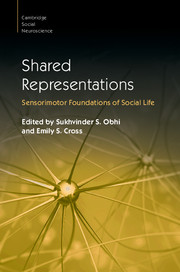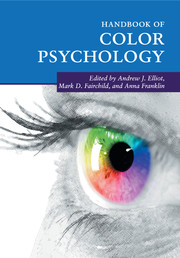Refine listing
Actions for selected content:
1174 results in Ebooks in neuroscience
20 - Emotional Convergence
- from Part IV - Understanding Others
-
-
- Book:
- Shared Representations
- Published online:
- 27 October 2016
- Print publication:
- 17 November 2016, pp 417-436
-
- Chapter
- Export citation
4 - Beyond Action
- from Part I - Foundations
-
-
- Book:
- Shared Representations
- Published online:
- 27 October 2016
- Print publication:
- 17 November 2016, pp 59-85
-
- Chapter
- Export citation
22 - Mirror Neuron Formation via Associative Learning
- from Part V - Learning and Development
-
-
- Book:
- Shared Representations
- Published online:
- 27 October 2016
- Print publication:
- 17 November 2016, pp 460-479
-
- Chapter
- Export citation
25 - Observational Motor Learning
- from Part V - Learning and Development
-
-
- Book:
- Shared Representations
- Published online:
- 27 October 2016
- Print publication:
- 17 November 2016, pp 525-540
-
- Chapter
- Export citation
19 - Complementary Actions
- from Part IV - Understanding Others
-
-
- Book:
- Shared Representations
- Published online:
- 27 October 2016
- Print publication:
- 17 November 2016, pp 392-416
-
- Chapter
- Export citation

Shared Representations
- Sensorimotor Foundations of Social Life
-
- Published online:
- 27 October 2016
- Print publication:
- 17 November 2016

Handbook of Color Psychology
-
- Published online:
- 05 April 2016
- Print publication:
- 17 December 2015
Chapter 6 - More than just a mirror: examining the cross-channel mimicry of emotional expressions
-
-
- Book:
- Emotional Mimicry in Social Context
- Published online:
- 05 March 2016
- Print publication:
- 11 March 2016, pp 107-124
-
- Chapter
- Export citation
Chapter 2 - The role of mimicry in understanding the emotions of others
-
-
- Book:
- Emotional Mimicry in Social Context
- Published online:
- 05 March 2016
- Print publication:
- 11 March 2016, pp 27-43
-
- Chapter
- Export citation
Contributors
-
- Book:
- Emotional Mimicry in Social Context
- Published online:
- 05 March 2016
- Print publication:
- 11 March 2016, pp viii-x
-
- Chapter
- Export citation
Works cited
-
- Book:
- Beauty and Sublimity
- Published online:
- 05 February 2016
- Print publication:
- 11 March 2016, pp 257-276
-
- Chapter
- Export citation
6 - Whatis aesthetic argument?
-
- Book:
- Beauty and Sublimity
- Published online:
- 05 February 2016
- Print publication:
- 11 March 2016, pp 178-214
-
- Chapter
- Export citation
Chapter 3 - Revisiting the Simulation of Smiles model: the what, when, and why of mimicking smiles
-
-
- Book:
- Emotional Mimicry in Social Context
- Published online:
- 05 March 2016
- Print publication:
- 11 March 2016, pp 44-71
-
- Chapter
- Export citation
Chapter 8 - Mimicry, emotion, and social context: insights from typical and atypical humans, robots, and androids
-
-
- Book:
- Emotional Mimicry in Social Context
- Published online:
- 05 March 2016
- Print publication:
- 11 March 2016, pp 162-191
-
- Chapter
- Export citation
2 - The idiosyncrasy ofbeauty
-
- Book:
- Beauty and Sublimity
- Published online:
- 05 February 2016
- Print publication:
- 11 March 2016, pp 46-75
-
- Chapter
- Export citation
Introduction: why and how we mimic emotions
-
-
- Book:
- Emotional Mimicry in Social Context
- Published online:
- 05 March 2016
- Print publication:
- 11 March 2016, pp 1-6
-
- Chapter
- Export citation
5 - MyOthelloproblem
-
- Book:
- Beauty and Sublimity
- Published online:
- 05 February 2016
- Print publication:
- 11 March 2016, pp 162-177
-
- Chapter
- Export citation
Chapter 1 - On the sharing of mind
-
-
- Book:
- Emotional Mimicry in Social Context
- Published online:
- 05 March 2016
- Print publication:
- 11 March 2016, pp 7-26
-
- Chapter
- Export citation
Dedication
-
- Book:
- Beauty and Sublimity
- Published online:
- 05 February 2016
- Print publication:
- 11 March 2016, pp v-vi
-
- Chapter
- Export citation
Contents
-
- Book:
- Emotional Mimicry in Social Context
- Published online:
- 05 March 2016
- Print publication:
- 11 March 2016, pp v-vi
-
- Chapter
- Export citation
